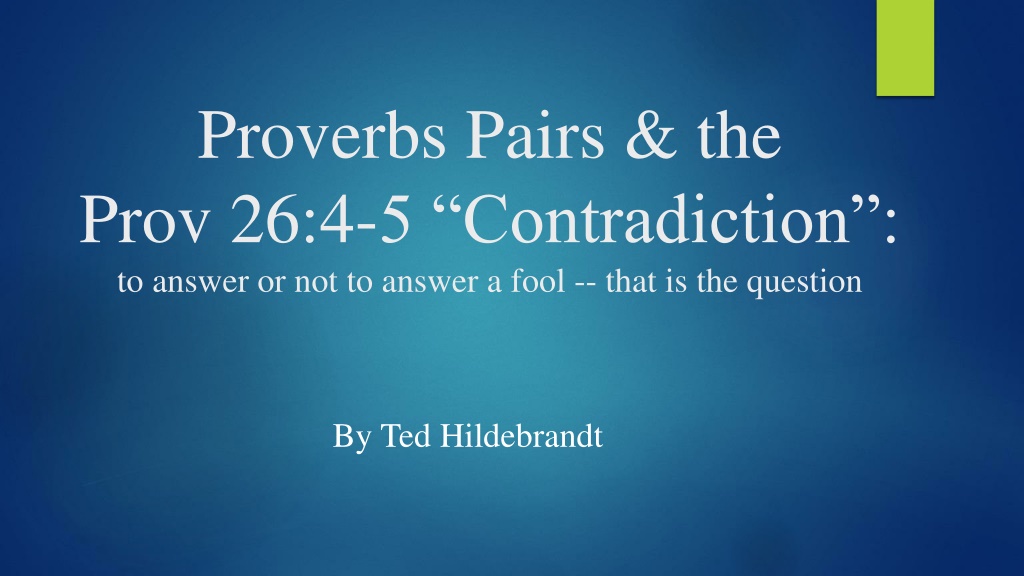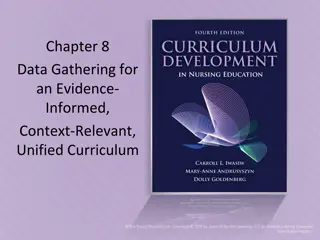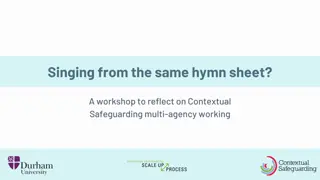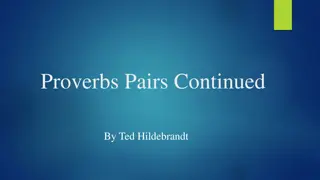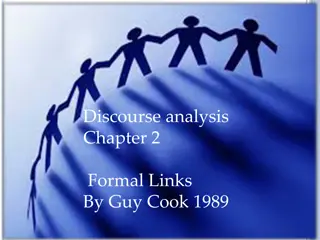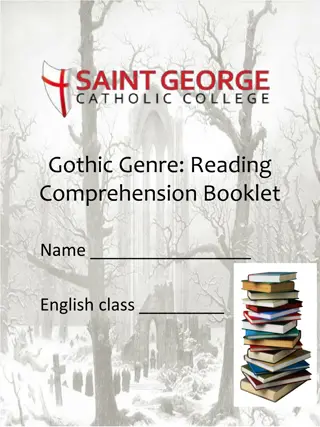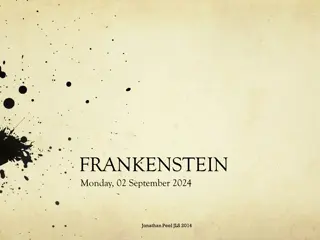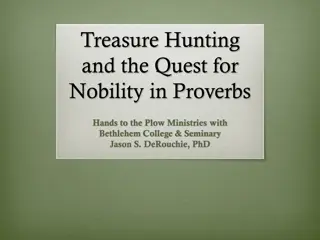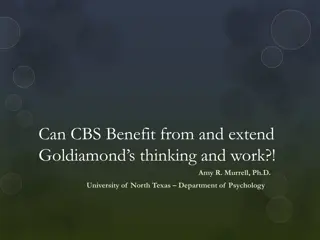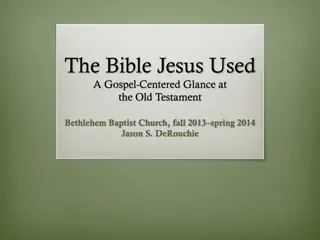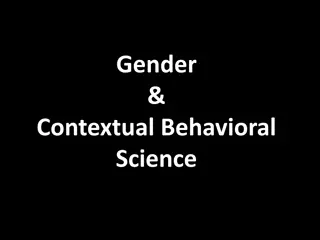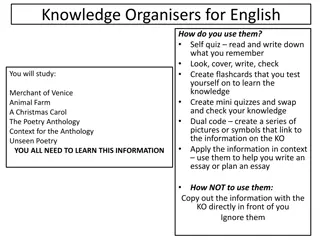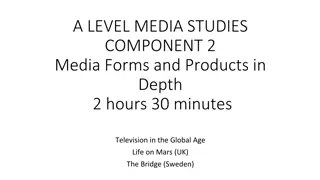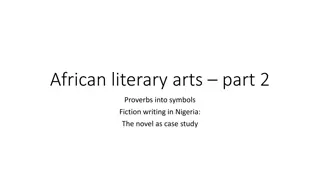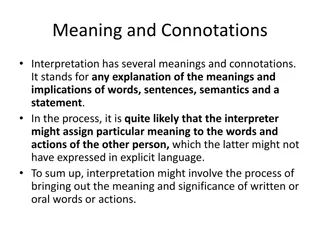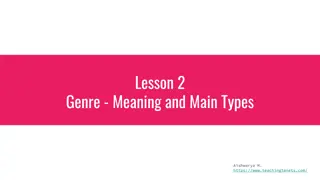Understanding the Proverbs of Proverbs 10-24: Contextual and Genre Insights
Exploring the arrangement and connections within Proverbs 10-24 to uncover the deeper meaning and significance of the proverbial wisdom. Analyzing the importance of context and genre in determining the meaning of words and the messages conveyed in biblical texts like Psalms and Proverbs.
Download Presentation

Please find below an Image/Link to download the presentation.
The content on the website is provided AS IS for your information and personal use only. It may not be sold, licensed, or shared on other websites without obtaining consent from the author. Download presentation by click this link. If you encounter any issues during the download, it is possible that the publisher has removed the file from their server.
E N D
Presentation Transcript
Proverbs Pairs & the Prov 26:4-5 Contradiction : to answer or not to answer a fool -- that is the question By Ted Hildebrandt
Questions being addressed Are the proverbs of Proverbs 10-24 just isolated units thrown together in a haphazard manner or is there some discernable and meaningful editorial ordering? If there is ordering, how does it function? What hermeneutic benefit is there in observing such inter- proverbial contextual connections? Are proverbs just boring banal platitudes reflecting a black/white retribution principle (act/consequence) which affirms the status quo [tradition] contra Job/Eccles.? (vid Hatton, 17ff) E.g. Prov 12:21
Importance of Context and genre in determining meaning Context of a Word meaning: What does trunk mean? tree trunk, luggage trunk, car trunk, body trunk, elephant trunk, rail line trunk, network trunk line. Genre: examples (newspaper front page, editorial page, cartoon page, classified ads, obituaries, documentary versus fictional story, Biblical genres: Historical narrative, prophetic utterance, psalms, parables, apocalyptic, laments, psalms of ascent, imprecations, proverbs, et al. -- form-meaning connection Genre matters Historical: locusts in plague on Egypt God s might revealed Prophetic judgment: Joel locusts/Day of the Lord; Apocalyptic: pit-locusts like scorpions, hurt humans (Rev. 9:3ff) Wisdom: locust dragging self along (old man Eccl. 12:5) -- NT John the Baptist eats
Importance of Context and genre in determining meaning Psalms editors work: Ps. 72:20; titles cf. Ps. 51; Elohistic Psalter (42-83 cf. Ps. 14:2, 4 and 53:2, Psalms of Asaph (Pss. 73-83) Sons of Korah (Ps. 42-49), Psalms of Ascent (Pss 120-134) Ps. 1 intertextual connections to Ps. 2 also Josh 1:8 sectional nexus; Pss. 42/43; 9-10. Prov 1-9 instructions; Prov 10-24 proverbial sentences, Hezekiah s men Prov 25-29; Important editorial comment: Prov 25:1 Prov 30 Sayings of Agur, Prov 31 Sayings of King Lemuel, Prov 31 VW [virtuous woman acrostic], instructions Prov 1-9 connected discourses Purpose: Show how editors built proverb pairs new level of meaning
Importance of Context and genre in determining meaning Several hermeneutical insights gained by the concatenation Proverb formation: 1 Sam 10:10-13 story proverb example [do chickens have lips, do bears sleep in the woods, is Saul among the prophets] Non-definition/definition: Proverb is a short, salty, significant, repeated and accepted statement often using metaphor/smile/hyperbole/generalization and summation Caution: Yes, proverbs are often generalizations but you can t universalize a proverbial statement complexity of life calls for discernment not simplistic guarantees, one aspect of truth for a particular situation Prov 22:6 train up a child Proverbs have never been considered as absolute truths by the people (Mieder, Twisted Wisdom, 1) Nature of proverbial interpretation a proverb is not a promise (genre), particular aspect of authority
Importance of Context and genre in determining meaning If there is intentional interaction between proverbs in pairs then one should seek the meaning the editors may have had in mind when they concatenated two individual proverbs into a pair. Intertextuality: relation of one text to another is an important field of study (vid. Psalms research G. Wilson et al.) Context of use: often to win a case (African proverbs); to win and argument; concluding/encapsulating a story (Prov. 1:19, 32), humor Prov. 23:29-35, 26:13. Stich in time, saves nine: NASCAR, HW exam What a poem means is discovered from how a poem means Form and meaning connected in poetry like non-verbal/verbal in human communication As we do not miss the author s poetic craft and intent, we also should not miss the editor s intent as the book is built up and shaped.
Importance of Context and genre in determining meaning Journey to discover meanings of a proverb and wisdom: Historical setting: Solomon, Hezekiah, Augur, Lemuel, sayings of the wise Literary expression: Aesthetics (Acrostic/chiastic/inclusios; phonology), Rhetorical (speaker/audience), Poetics (parallelisms, sound/sense; terseness), Figurative language (metaphor/smile/metonymy/hyperbole, parody, generalization etc.), Literary form (what is a proverb? What forms are used (e.g. Pr 30)? How are they put together?--pairs),
Importance of Context and genre in determining meaning Cultural/ setting (royal court), folk, teaching [school], judicial, and Social factors (king, scribes, teachers, students ) also help us Canonical function: how are proverbs used in narratives (1 Sam 24:13 et al., vid. Fontaine, Traditional Sayings in the OT), Prov 26:4-5 antilegomena for Proverbs
Willy-nilly Advocates: Pr. 10-29 W. Oesterley ( Proverbial Pairs, JBL, 107.2, p. 207f ) R. Gordon B. Lang J. C. Rylaarsdam B. Childs Atomistic, self-contained, disconnected, helter-skelter, disarranged
What is a proverbial pair? Definition: Two adjacent proverbial sentences that are bonded together (whether by means of phonetics, semantics, catch words, syntax, rhetorical device, situation or theme) into a higher architectonic unit. Weeks discovered such adjacent sayings in 1994 pp. 21-33; ignores my JBL article in 1988 6 years late. Literary/editorial craftsmanship Prov 25:1 editing, selecting and ordering, Examples of longer units in Proverbs: Prov 31:10-31 acrostic, Prov 6:16-19 numerical sayings, imagined stories Prov 24:30- 34, instructions Prov 1:8-19
How frequent are pairs Proverbs 10-29 [595 verses] 62 examples (124 verses - 21%) in pairs [e.g. 15:16-17 two better than proverbs in adjacent/concatenated yet only 21x in all Proverbs] E.g. of one proverb contextualizing another: Prov 10:15-16 The wealth of the rich is their fortified city, but poverty is the ruin of the poor. The wages of the righteous is life, but the earnings of the wicked are sin and death. (Hatton, 39)
Double Chiastic Structure of Proverbs 26:1-12 (Steinmann, 524) On What is fitting treatise on Hermeneutics of Wisdom (Van Leeuwen) [Toy calls it the Book of Fools in Proverbs] A Honor not fitting for a fool (26:1) B Inconsequential curse (26:2) C Double comparison: discipling a fool (26:3) D Not answering a fool (26:4) D Answer a fool (26:5) C Double comparison: the folly of using a fool for important business (26:7) B Inconsequential proverb (26:7) A Honor is not fitting for a fool (26:8)
Double Chiastic Structure of Proverbs 26:1-12 (Steinmann, 524) E1 A fool s stupidity (26:4) E2 A fool s stupidity is his wisdom (26:5) F The folly of using a fool for important business (26:6) G A proverb in the mouth of fools (26:7) H Honor is not fitting for a fool 26:8, cf. 26:1) G A proverb in the mouth of fools (26:9) F The folly of using a fool for important business (26:10) E1 A fool s stupidity (26:11) E2 A fool s wisdom (26:12)
Fool and Worse (being wise in your own eyes 26:5, 12) Hermeneutics/evaluating what is fitting Van Leeuwen, 104 Honor given to fool (26:1, 8 repetition) Rod for back of fools (26:3) Answering a fool or not (26:4, 5 repetition) Sending a fool as an envoy (26:6) Fool spouting a proverb (26:7, 9; repetition) Hiring workers (drunk/fool) (26:10)
Pairing Variations Variations: Triads: 23:26-28, 24:10-12 et al. Weeks, Early Isr Wisd p. 22, 30 Detached/split pairs: 10:8/10, 16:32/17:1, 17:26/17:1 Pair plus one detached: 15:1-2, 4; 15:8-9, 11; 20:16-17, 20 Strings/Clusters [Heim]: 11:9-12; 15:29-33 et al.
Five Examples: Pair #1 Prov 26:4-5 Do not answer a fool according to his folly; or you will be like him yourself. Answer a fool according to his folly, or he will be wise in his own eyes.
Contradictory Proverbs Contradictory Proverbs well known phenomena (Alster, Proverbs of Ancient Sumer, v. 1, xiii) Part of the genre usage in almost all languages that use proverbs. Examples of anti- or twisted proverbs taken from English [Wolfgang Mieder, Twisted Wisdom: Modern Anti-Proverbs, 1999] Sumerian [Alster, 1:50] and Yoruba [Nigerian] proverbs and in Proverbs [Hatton, Contradiction in the Book of Proverbs (2008)] and such paradoxes more broadly in Scripture (sovereignty/free will; faith/works, trinity )
Contradictory Proverbs: English English paradoxical/contradictory proverbs part of the genre Vid. W. Mieder & Litovkina, Twisted Wisdom: Modern Anti-Proverbs(1999; world s leading paremiologist)- 320 proverbs/3,000 matching twisted or anti-proverbs Absence makes the heart grow fonder Absence makes the heart grow fonder for someone else Absence makes the heart to wander (variational technique rhyming word substitution) or, Out of sight, out of mind (Mieder, 1996, 599; in Alster, PAS, v. 1, xiii) contrary or anti-proverb
Proverbial variation/parody/Anti-proverbs An apple a day, keeps the doctor away. X a day, keeps Y away A crisis a day, keeps impeachment away (1991) Bill Clinton A laugh a day, keeps the psychiatrist away. An effort a day, keeps failure away. An onion a day, keeps everybody away. A chapter (of the Bible) a day, keeps Satan away. An apple a day keeps the doctor away. And so does not paying your bills. Apples are so expensive these days, you may as well have the doctor Better than an apple a day (Campbell's Soup advertisement) Old hen "Let me give you a piece of good advice." Young hen "What is it?" Old hen "An egg a day keeps the ax away." (Meider, Twisted Wisdom, 37f)
Contradictory Proverbs: English Early bird gets the worm // Second mouse gets the cheese. banter response of Natanya [daughter] Look before you leap. He who hesitates is lost. If at first you don t succeed, try, try again. Don t beat your head against a wall. You re never too old to learn. You can t teach an old dog new tricks. Many hands make light work. Too many cooks spoil the broth. Save for a rainy day. Tomorrow will take care of itself.
Contradictory Proverbs: Sumerian [ca 1900-1800 BC] One cannot take (anything) out of the mouth of the poor (2.27) So lowly is the poor man that what is taken from his mouth is thus restored (2.30) Alster, 1: 2.27 versus 2.30 (pgs. 50-51)
Contradictory Proverbs: Yoruba Yoruba people of Nigeria relish proverbs. Used by the elderly, who are viewed as repository of proverbs, to buttress his/her point etc. Timothy Akanbi, Contradictions and Inconsistencies in Human Nature: Evidence from Youruba Proverbs, Journal of Language and Literature 20.2 (Oct 2020) 261-69. 1) Empty barrel makes the loudest noise, the one that has content does not make noise. 1) If you do not praise yourself, nobody will praise you 2) A warrior does not receive a wound on the back 2) To fight and run is the beauty of bravery
Contradictory Proverbs in Proverbs Peter T. H. Hatton, Contradiction in the Book of Proverbs: The Deep Waters of Counsel (2008, Ashgate) these contradictions are not imperfections but part of a subtle and profound didactic strategy to awaken the critical faculties of the reader. (p. 1) i.e. eddies in the flow of Proverbs (p. 4) Hatton writes: We shall discover that Proverbs achieves its goal of awakening its readers to wisdom by introducing contradictions into the flow of its sayings. This defamiliarizes not just the sayings concerned but also the context, the other sayings around them. The reader [audience] is goaded into paying renewed attention to a form of wisdom whose very familiarity might lead to it being dismissed. (p. 13) pondering hermeneutic evaluating what is fitting [timing, people, situation (sociological/rhetorical)]
Contradictory Proverbs in Proverbs Internal contrary items in a single proverb Prov 13:24: Withholds his rod, hates his son; who loves him disciplines him early Prov 27:6 Trustworthy are a lover s blows but dangerous the caresses of one who hates. Proverbs 31:4-7 powerful ought not drink [justice impaired]; powerless may drown their woes (Heerden, 596)
Contradictory Proverbs in Proverbs Prov 25:15 With patience a ruler may be persuaded, and a soft tongue can break a bone. riddle: what is soft yet breaks a bone? Ahiqar 103, ANET, 429 papyri from 400 s BC, telling of Assyrian court of Sennacherib (ca. 700 BC) & Esharhaddon (ca. 680 BC). International flavor of proverbs. Cf. Prov 22-24 & Amenemope, 1 Kgs 4:30-34. By controlling temper one gulls a commander, and a soft tongue breaks a bone.
Nature of repetition in Proverbs Wonderful study by Daniel Snell, Twice Told Proverbs (1993) and extensively developed by Knut Heim, Poetic Imagination in Proverbs: Variant Repetitions and the Nature of Poetry (2013). Prov 26:1 Like snow in summer and like rain during harvest, so honor does not befit a fool Prov 26:8 Like tying up a stone in a sling, so is giving honor to a fool. Prov 26:7 Legs dangle from a cripple, and a proverb from the mouth of fools. Prov 26:9 A thorn goes up in the hand of a drunkard, and a proverb in the mouth of fools Others: 10:1 // 15:20; 10:6 // 10:11; 10:8 // 10:11. cf. Prov 26:4 & 5
Cohesion: Prov 26:4-5 DoNOT answer a foolaccording to his folly; lestyou will be like him yourself. Answer a foolaccording to his folly, lesthe will be wise in his own eyes. -Act [not answer] - consequence [you ] +Act [answer] + consequence [he ] Verb:Imperative + N:Obj:Fool + PrepPh:Manner:according to Neg:Lest - [Verb:Imperfect] Consequence [you/he] Waltke notes the assonance in the second line of each
Cohesion: Prov 26:4-5 Semantic Cohesion: not random Fool ( ; 49x in Prov.; 11x, 22% in ch. 26 high density ch.) According to his folly ( ; 2x in Prov. only here) Answer ( low frequency word) 8x in Prov. Only here two in a row Or / lest ( ) 17x in Prov. 7x in initial line, 10x in 2nd ; in initial position in both second lines (cf. 25:16-17 another pair; 2x in initial 2nd line position)
Pre-Separateness of Proverbs 26:4-5 from 26:3 Separateness of this pair (26:4-5) as a distinct unit 26:3 A whip for the horse, a bridle for the donkey, and a rod for the backs of fools! While the fools (pl.) does link with Prov 26:4-5, the topic is disciplining a fool not answering/reasoning with them; both do deal with the theme of how to treat/deal with a fool. Note the fools in 26:3 is plural while in 26:4-5 it is singular Note 26:3 is highly image/metaphor based while 26:4-5 lacks such Note 26:3 is tri-cola whereas 26:4-5 both bi-colons
Post-Separateness of Proverbs 26:4-5 from26:6 Prov 26:6 Like cutting off one's feet or drinking violence, is the sending of a message by the hand of a fool. Note simile: like cutting off one s feet (not=26:4-5) note 26:6 does connect itself more tightly with 26:7 which is also metaphorically about a fool and feet/legs, metaphor not = 26:4-5 Here the warning is against using a fool to accomplish a task, not trying to correct his reasoning. Fool in 26:6 positioned last; not in first colon as 26:4-5 Note also 26:1, 3-12 all do address the fool so there may be higher order bonding but 26:4-5 is definitely a unit that stands by itself.
Proverbial interaction: Prov 26:4-5 What is the significance of putting these two strongly linked proverbs back to back? Sometimes it may be worth the personal risk to stop a fool from moving downward to the position of being wise in his own eyes i.e. arrogance is worst than and less reversible than being a fool (26:12) The higher order reasoning is achieved by the apparent contradiction between the two proverbs when and why should one answer or not answer a fool Note Proverbs antilegomena canonical status of Proverbs which was questioned based on this apparent contradiction.
LXX Solutions to heteroglossalic texts Greek version (ca 250-100 BC) translation in Alexandria from Hebrew Hatton, after examining the contradictory proverbs notes how the LXX translated them: Its translations of the verses in question removed, or toned down, the potential offence. (p. 117, 141ff) E.g. Different attitudes in Proverbs towards bribes. Prov 17:8, 18:16, 21:14. Especially 15:27 // 17:23. Beware bland harmonization
LXX Solutions to heteroglossalic texts Prov 17:23 The wicked accepts a bribe in secret, To pervert the ways of justice. [bribes = wicked] Prov 21:14 Hebrew MT: A gift [bribe] in secret averts anger, and a concealed bribe, strong wrath. Greek (LXX): A secret gift [generosity] turns away anger, but he who forbears giving raises strong wrath. Prov 21:13 (LXX) He who closes his ears so as not to hear the weak, he also will cry out and there will be nobody who hears. LXX shifts it to generosity linking 21:14 to 21:13 softening the worldly wisdom that a bribe may be beneficial sometimes contra 17:23 = bribes bad
LXX Solutions to heteroglossalic texts Prov 17:8 Hebrew MT: A precious stone the bribe in the eyes of its masters in every way it turns, it prospers. Greek (LXX): A reward of precious things is instruction to those who make use of it, wherever it may turn, it shall prosper LXX totally softens it eliminating the endorsement of bribes. MT is more in line with 17:23 (cf. 15:27) The wicked accepts a bribe in secret, to pervert the ways of justice.
LXX Solutions to heteroglossalic texts Hatton, p. 168 concludes after examining the divergences between the MT and LXX that: my contention that the Greek version of Proverbs is sensitive to the spikey , contradictory nature of the Hebrew text and repeatedly translates in a way that smooths out the contradictions, could be a valuable hermeneutic device in identifying similar complexities in others scriptures. Hatton, p. 170: By attending to the complex dialogues in the book; by refusing to jump to premature conclusions; by reading sensitively and holding contradictions together rather than seeking to harmonize them away the reader can become one of those who are able to act wisely, responsibly, in a complex world.
Suggested Solutions Prov 26:4-5 W. Van Heerden, in Strategies applied by interpreters of the Paradox in Proverbs 26:4-5 (Journal of Semitics, 17.2 2008) 591-617 follows Norrick How Paradox Means (Poetics Today, 1989, 551-62) 3 ways: 1) Separating frames of reference: The farthest way about is the nearest way home Farthest (geographical) = nearest (temporal/closer valued); 2) Averaging opposites: She s awake and she isn t (in the process of waking) in-between 3) Modifying one term: A friend to everyone is a friend to no one works on the term friend seeming friend versus true BFF friend 4) Vicious circle: Nothing is certain but uncertainty. emphatic function
1) Separating Spheres of Reference Fox notes the following solutions have been proffered (II:793f): Don t answer back in matters of Torah but answer in ordinary affairs (b. Shabbat 30b) Don t answer back in mundane affairs only in religious matters (Sa adia) Don t answer when audience knows both you and the fool, answer when neither of you are known by the audience (Mid. Prov.) Don t answer if by answering you d be put on same plain as fool, Answer back when fool is claiming same status as wise man. Fox says all these are arbitrary and not derived from the text.
Separating Spheres of Reference Seitel (1994: 127; van Heerden 614) contends that proverb meaning depends on the social context of proverb use (factors determining the relationship between the proverb user and the addressee), plus one s understanding of the proverb situation (the relation between the parts of the proverb), plus one s understanding of the social situation (the relation between the parts of the social situation), plus an assessment of the analogy between the proverb situation and the social situation, not to mention the rhetorical strategy applied by the user.
1) Separating Spheres of Reference Fox says by placement Prov 26:5 has the last word (contra Meinhold/van Leeuwen says the 26:4 majority advice that 26:5 is the minority report) Waltke (II:349) rejects the privileging approach saying both are always true. To be sure, there is a time to be silent and a time to speak (Eccl. 4:5), but one must always, not in only certain situations, answer a fool to destabilize him, but, always, not sometimes, without becoming like him. Does seem like vs. 4 the focus is on damage to yourself, while 26:5 focuses on the damage to the fool himself based on the pronominal focus of the consequence [lest you be like him // lest he be wise in his own eyes worse state than being a fool (26:12)]
1) Separating Spheres of Reference Menziwa (2000:108) 26:4 rules but if the fool continues to pester you then 26:5 response may be necessary (separate spheres; Heerden 597)
2) Averaging Opposites Van Heerden mentions Whybray and Mckane as holding that each proverb encompasses only partial truth and hence must be taken together to get the fuller picture (van Heerden, 598) based on the nature of proverb this makes sense but not the complete picture
3) Word Meaning modification Van Heerden mentions LXX + NASB (van Heerden, 602) K ( ) preposition like as LXX uses (v. 4) and (v. 5) according to his folly (v. 4) and as his folly deserves (v. 5) NASB: v 4 according to his folly // v 5 as his folly deserves ) - v 4 = not answer a fool; v. 5 = humble or rebuke (van Heerden, 599) Buhlmann takes answer ( Today s English Version: v. 4 If you answer a silly question v. 5 Give a silly answer to a silly question If softens tension
Reflections on Solutions I like Mieder and Paremiologist s approach that such proverb dueling is part of the genre found almost universally in proverbial collections and citations. It sparks higher order thinking, interpretive insights, proverbial playfulness, imagination and reflection (vid. Twisted Wisdom, Mieder and Litovkna). Proverbs relation to truth (contra universal propositional truth approach). Mieder says of international proverbs
Proverbial interaction: Prov 26:4-5 Clash gives way to insight: what is your purpose in dealing with this fool s question? There is a time to answer and a time not to, depends situation proverb not universal absolute truth what is a proverb? Its authority? Pronounal solution : you (v 4) / he (v 5) Wisdom/discernment [hermeneutic of what is fitting]-- not a formula or algorithm, life is complex, sole proverb only one aspect of life. Pair shows complexity. Why this pair? imagination, pedagogical, hermeneutical/interpretational insight, playful, entertainment, riddle, cognitive dissonance and development, knowing when/how/what is fitting to address a fool Importance of pairs in providing a proverbial dialogic setting by the editor(s)
Conclusion on pair #1 [Prov 26:4-5] The sum is greater than the individual parts. Each proverb has its own wisdom but when seen together wisdom demands higher order thinking about situations and life complexity is called upon Purposeful juxtaposing by the editors, not random ordering of individual isolated proverbs Methodologically when reading proverbs look at the one before and after it for relationships for pairs/triads/strings [clusters] and variational repetitions for intertextual interactions.
Conclusion on pair #1 [Prov 26:4-5] Van Leeuwen summarizes: Wisdom does not always mean doing the same thing, even in superficially similar circumstances. Yet the juxtaposition of these admonitions drives one to reflect on the limits of human wisdom, for no clue is given to help the reader identify which fool should be ignored and which spoken to. Of two viable courses of action, we do not always know which is fitting . (1997; 224 / 1988: 99, Van Heerden, 606)
Conclusion on pair #1 [Prov 26:4-5] Hoglund concludes: (346; van Heerden, 611) To enter into dialogue with the fool is both an obligation and a threat for the wise. Thus Proverbs 26:4-5 for a proverb pair intentionally concatenated to push the wise toward higher order thinking, imagination, using the proverbial pair with its repetition and with a certain amount of playfulness and parody to accomplish the editor s purpose of thinking more deeply about what is fitting in dealing with a fool (Prov 26:1-12).
Resources: Waltke, Steinmann, and Fox -- Major commentaries on Proverbs Hatton, Peter T.H. Contradiction in the Book of Proverbs: The Deep Waters of Counsel (Hampshire, England: Ashgate Publishing Limited, 2008). Hildebrandt, Ted. Proverbial Pairs: Compositional Units in Proverbs 10-29, Journal of Biblical Literature 107.2 (1988) 207-224. Mieder, Wolfgang. The Wisdom of Many: Essays on the Proverb, and Twisted Wisdom: Modern Anti-Proverbs. Mieder is world s leading expert on the proverb Heim, Knut. Proverbs 26:1-12: A Crash Course on the Hermeneutics of Proverbs Reception and a Case Study in Proverb Performance Response, (Die Welt des Orients, 40 (2010) 34-53. Van Heerden, W. Strategies Applied by Interpreters of the Paradox in Proverbs 26:4-5 Journal of Semitics 17.2 (2008) 591-617. Hoglund, Kenneth G. The Fool and the Wise in Dialogue: Proverbs 26:4-5 in Roy Zuck s Learning from the Sages (Baker Books, 1995).
